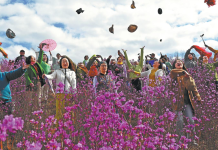BEIJING: While Yu Xiaopeng and his colleagues take care of 78 captive milu at the Dafeng Milu Deer National Nature Reserve, Liu Bin focuses on its 1,350 wild deer.
As director of the reserve’s security office, he is responsible for cracking down on poaching and rescuing milu that stray from the reserve. Poaching of the deer has always been rare, Liu said. “People living around the reserve know the deer is under State protection,” he said. “Hunting a protected animal is a felony.”
Poachers’ targets were usually wild ducks spending winter in the reserve, he said, but as people’s environmental awareness has risen “the cases are few and far between”.
However, he said, the frequency of rescue operations has increased rapidly as the reserve’s wild milu population has grown.
In 1998, 54 deer became the first generation of milu to be reintroduced to the wild at the reserve. Another four wild-release operations were staged in 2002, 2003,2006 and 2016 and the reserve is now home to the world’s largest wild milu population.
Originally they mainly roamed an area of some 1,000 hectares that is part of the reserve’s core zone. However, there is no fence surrounding that part of the reserve, and as the population of wild milu has grown they have begun to explore the world outside the reserve. Liu said wild milu had been seen in Rudong, Jiangsu province, about 100 kilometers south of the reserve. “They’ve reached 70 to 80 kilometers north of Dafeng and gone west for 50 km,” he said. “Some have even appeared on the outskirts of Dafeng city.”
Milu are among the world’s largest deer and accidents can happen when they come into contact with humans. They range from stags’ antlers being stuck in tree branches or fish pond fencing, to the deer falling into pits, being trapped in the intertidal mud flats facing the Yellow Sea, and being hit by cars.
From 2017 to last year, Liu’s department handled 202 rescues and helped 399 deer out of trouble. Accidents were more frequent in autumn and winter, Liu said, because the deer scattered to look for food after gathering to mate and breed in spring and summer.
To launch rescue operations as quickly as possible, Liu and five colleagues patrol the reserve on the 5th, 15th and 25th of every month and are on call “24 hours, seven days … in case there are reports from 110 police calls”, he said. At the beginning, the rescue work was “quite a challenge”, he said, because they had no rescue equipment. Year by year, they have become better equipped. Now they have five patrol cars, a powerboat for operations on the mud flats, three rubber dinghies and tranquilizer guns. – The Daily Mail-China Daily News exchange item






